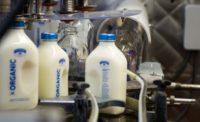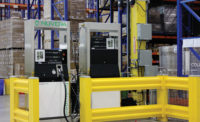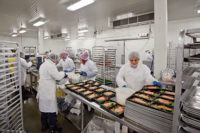From wastewater management to LED lighting to enhanced refrigerant management, Refrigerated & Frozen Foods uncovers the latest in green technologies for today’s cold storage distribution and processing plants.
When it comes to green construction, food processing facilities can never be too environmentally friendly. From wastewater management to LED lighting to enhanced refrigerant management, all roads lead into a more environmentally-friendly way of producing cold food products.
Here’s a snapshot of what some of today’s refrigerated and frozen food processors and distributors are doing to launch their manufacturing plants into the future.
ConAgra Foods Lamb Weston—operates with efficiency, sustainability in mind
ConAgra Foods Lamb Weston, Kennewick, Wash., holds a strong commitment to operating sustainably across all manufacturing facilities. However, two facilities were developed and built with sustainability in mind.
The sweet potato processing plant in Delhi, La., for example, is LEED Platinum certified, and is said to be the first frozen food processing plant worldwide to achieve this level of certification, says Trudy Slagle, project manager, sustainability.
ConAgra Foods Lamb Weston also expanded its 192,000-square-foot frozen potato processing plant in Boardman, Ore., using LEED standards. The $200 million investment added a new processing line, thus increasing capacity for making French fries and other frozen potato products.
Both facilities optimize energy performance through energy recovery, LED lighting and motion detection and enhanced refrigeration system management. Other sustainable aspects include water-efficient landscaping and on-site recycling and waste diversion.
“Five of our facilities hold Energy Star Certification—Park Rapids, Minn., and Warden, Quincy and Richland, Wash., and American Falls, Idaho. Thirteen of Lamb Weston’s facilities are what ConAgra Foods recognizes as Zero Waste Champions, meaning they divert more than 95% of waste from landfill annually. Seven of these locations divert 99% of waste from landfill,” says Slagle.
Plus, most ConAgra Foods Lamb Weston plants are home to employee-led green teams that identify ways to operate more sustainably and work together with management to implement green programs.
“ConAgra Foods Lamb Weston has a capital investment program that funds not just green construction, but also energy efficiency and infrastructure projects that promote and enable sustainable processing,” adds Slagle. “Several of our plants have used track-and-tune programs to seek out and implement low-cost energy savings opportunities. We’ve identified opportunities to conserve water through re-circulation systems in our plants, and employee engagement programs have identified areas where we can better conserve resources. The company also re-uses process water for irrigating farmland at eight facilities. We further maximize our water resource use at four of our facilities by using wastewater and anaerobic digestion to generate biogas, offsetting natural gas requirements at these locations. As a result of these efforts and our overall commitment to sustainability, Lamb Weston has decreased its carbon footprint by approximately 3% from 2008 to 2014.”
OSI Group—pioneers of environmentally responsible meat processing
Over the past two years, OSI Group, LLC, Aurora, Ill., has gone to great lengths to design, build and operate the most environmentally responsible meat processing facilities in the world.
Take for instance, its Henan Province, China, facility, which sits on nearly 1.4 million square feet of land, spanning 585,018 square feet and is said to be the first LEED-certified protein plant in China. This beef and poultry processing site features a heat recovery system, a heat pump system that captures latent heat, extra high solar reflectance index roofing system, a rainwater harvest system, solar-energized outdoor lighting, indoor LED lighting, energy efficient motors, high voltage-powered compressors to reduce electrical line loss and real-time energy monitoring systems.
Meanwhile, OSI Food Solutions in Ostróda, Poland, consists of a 3-story, 64,600-square-foot processing and storage building that incorporates water-saving faucets, indoor and outdoor LED lighting, renewable energy sources, above-standard building insulation, a chemical-free water treatment system, rainwater capture and heat recovery and an energy monitoring system.
“[We have] made extensive changes to [our facilities] to accommodate a number of forward-thinking, sustainable initiatives,” says Alison Kovaleski, director of communications and marketing.
In the United States, sustainability played a significant role in the site selection and subsequent development of the pre-cast, tilt-up, 135,200-square-foot Riverside, Calif., facility, where OSI incorporated a variety of “green” components and technologies into the final design. Sustainable features include tinted glass and reflective “white” roofing materials to minimize load on air conditioning systems, “smart” lighting panels, variable frequency drives, masonry block made of recycled concrete materials, bulk water storage to facilitate re-use, ammonia diffusion systems, state-of-the-art pre-treatment systems and high-efficiency low NOX boilers.
“Historically, it has been more expensive to retrofit sustainable solutions in existing facilities than to design and build with them in a Greenfield project. [Previously], there have been fewer options for retrofit solutions than new construction, and retrofit solutions may not always be as efficient or effective as new construction,” says Larry Glaser, assistant vice president and director of operations support.
OSI also maintains some installations to recover heat from one process and re-apply that energy into an alternative process.
“We have state-of-the-art cook/chill process systems that maximize the heat transfer while allowing us to retain the water for re-use, minimize loss of thermal energy and significantly reduce our use of water, which is a precious commodity. Our closed loop systems keep the heating/cooling medium in circulation with specific process monitoring controls in place to ensure food safety and minimize variances,”says Mike Yeager, vice president of engineering.
WhiteWave Foods—opens company’s first certified-green manufacturing facility
WhiteWave Foods announced green building certification of its 325,000-square-foot beverage manufacturing facility in Dallas, Texas. The facility, which produces Silk soymilk, almondmilk and coconutmilk, Horizon Organic milk and International Delight flavored coffee creamers, earned LEED certification for New Construction.
“WhiteWave is committed to changing the way the world eats for the better, and we recognize that how we make our products is just as important as what we make,” says Blaine McPeak, president. “Improving the environmental profile of our manufacturing process helps us to offer consumers more sustainable food choices and reinforces our commitment to reduce our environmental impact.”
Green attributes of the facility include nearly 90% of all demolition and construction waste associated with the project diverted from landfills, landscaping that requires no irrigation, fixtures that use 30% less water, 100% of wood-based building materials are certified sustainable by the Forest Stewardship Council, nearly half of all building materials were manufactured within 500 miles of the site and the use of materials and design techniques that facilitate solar reflectivity, helping to address “heat island” challenges associated with Dallas’ urban development
The LEED certification of the Dallas plant follows LEED certification of the company’s North American operating company headquarters in Broomfield, Colo.
Rader Farms—proprietary electrostatic technology adds nutrients to frozen fruit offerings
Rader Farms, the Lyndon, Wash.-based division of Inventure Foods, incorporated proprietary electrostatic technology when adding nutrients to its new Fruit Plus Vitamins line of better-for-you whole fruit. This patent-pending technology topically applies the nutritional boost to its fruits, enhancing the vitamin content while maintaining the taste and visual appeal of traditional frozen fruit.
“We had to overcome a number of challenges—one of which is the fragile nature of some berries such as raspberries,” says Dan Hammer, vice president and general manager, frozen division for Inventure Foods, Inc., Phoenix, Ariz. “Once those berries are free from the vine and its core, they are susceptible to damage. The system we developed had to be carefully designed in order to produce fruit that is both visually appealing and delicious. Ultimately we borrowed knowhow from every corner of Inventure’s collective R&D and manufacturing expertise in order to develop this unique ability.”
Rader Farms aims to harvest, sort, wash and individually-quick freeze its berries within an hour or so after being picked, so they retain that peak-of-harvest taste.
“Our vitamin-enhanced whole fruit ultimately enhances the naturally-occurring vitamins found within whole strawberries, blueberries and blackberries, and we boost the nutrition levels with five additional vitamins, including B1, B6, D, E and K,” says Hammer. “So, while a traditional 1-cup serving of mixed strawberries and blueberries may provide 65% of the daily recommended value (DV) of vitamin C and 2% DV of vitamin A, a single 1-cup serving of Fruit PLUS Vitamins offers 125% of vitamin A, 145% of vitamin B1, 145% of vitamin B6, 250% of vitamin C, 175% of vitamin D, 105% of vitamin E and 50% of vitamin K, all without impacting the taste or texture of the fruit. We feel it may be a game changer for the frozen fruit consumer.”
Just this year, Rader Farms invested in a second individually-quick frozen line that allows the company to exponentially expand its processing volume, adds Hammer.
“Rader has certainly positioned itself for more growth and innovation.”
Bel Brands—re-uses water to reduce water consumption
Chicago-based Bel Brands USA, a subsidiary of Paris-based Bel Group, opened the doors to its new Mini Babybel production facility in Brookings, S.D. This $144 million plant sits on 170,000 square feet and applies state-of-the-art and proprietary manufacturing processes developed in the company’s Evron, France, facility. The plant will also use about 500,000 pounds of milk per day, which is purchased through two dairy co-ops in the region—Dairy Farmers of America and Land O’Lakes.
“We are using reverse osmosis to concentrate our whey. This equipment extracts the pure water from the whey,” says Thierry Vialard, project manager for the Brookings plant. “Our plan is to re-use this water internally, [thus reducing] our water consumption from the city. We also are using a biodigestor that is producing biogas. This biogas will eventually be used to heat the effluents instead of the natural gas. We are also studying options for using the harsh winter in South Dakota in doing ‘free cooling.’”
The Brookings plant is also equipped with a cooling system that’s dedicated per usage with adequate temperature (45 for HVAC, 36 for process and 28 for storage). Its cleaning system is optimized to reduce the water consumption and chemical products usage, and operators conduct full and detailed monitoring of water and energy consumption to track the waste, adds Vialard.
Goya Foods—reduces energy consumption with extensive preventative maintenance program
To the folks at Goya Foods, re-engineering an old building to become more energy efficient is often times less expensive than building a completely new facility. However, the Secaucus, N.J.-based ethnic food processor built a 60,000-square-foot refrigerated space in Miami to house its refrigerated and frozen food lines.
Energy efficient features include an ammonia system, heavily insulated walls and roof panels of freezers and coolers, high-speed insulated doors, motion detection lighting and an extensive preventative maintenance program, which includes monthly inspections of all systems.
“Our Miami facility is located in the hurricane belt, so solar technology hasn’t been an option for us due to the building code restrictions in Miami-Dade County, which require wind loads of 140 miles per hour,” says Angel Portuondo, director of operations for Goya Foods of Florida. “However, this is an option that we will explore as the technology continues to develop and grow. We would also consider switching to LED lights in the future when the cost of retrofitting gives us a more reasonable return on investment.”
Top 10 Tips on How to Go Green
Going green is not a decision that’s made overnight. However, adopting green construction practices can definitely help any cold food processor achieve significant cost savings, almost immediately. That’s why the Green Building Initiative (GBI) was created—to accelerate the adoption of building practices that result in healthier, more energy efficient and environmentally sustainable buildings by promoting practical green building approaches.
“Re-use is most often less expensive than ground-up construction. Also, preserving/re-deploying building components limits embedded carbon to the amount that already exists in on-site materials,” says Jerry Yudelson, president, and Tom White, chief engineer. “It’s false economy to replace existing standard or conventional components, equipment and buildings with more efficient, corresponding options if resource management protocols are not in place to reduce environmental impacts. Such effective practices are needed to assure that a new alternative would use energy and water more efficiently or necessarily generate less waste. Also, life-cycle-costing approaches can be employed to compare various replace-or-keep alternatives.”
Here are Top 10 tips on how cold food processors can “go green”:
- Implement ISO 5001 and strategic energy management practices.
- Employ continuous energy improvement, which is said to offer a 25% energy savings in 10 years.
- Only source “green” ingredients to reduce overall carbon footprint and minimize embedded energy of supplier products and ingredients.
- Opt for green packaging, which minimizes refuse/garbage and uses recyclable and earth-friendly materials.
- Repair steam and compressed air leaks.
- Coordinate process schedules to shave or shift electricity power peaking, thus avoiding much higher demand and energy charges for peak demand.
- Install condensing boilers that are equipped with condensate steam traps.
- Install variable frequency drives for motors, pumps and operating fans at frequencies that match system loads, adjusting to more efficient operation for given pressures at required flows.
- Implement energy-efficiency strategies for refrigeration, which can include properly sized evaporator coils, better controllers and proper insulation of coolers and freezers.
- Set goals, manage energy use and measure results.













